 |
Consequences of Vatican II
What about the Orthodoxy
of Mother Teresa?
Marian T. Horvat
The care the Catholic Church traditionally has taken in proclaiming our Blesseds and Saints is well-known and admirable. Painstaking inquiries are made to prove the complete orthodoxy of the servant of God’s writings and sayings, practice of heroic virtue, and exemplary life to be offered as a model for the whole Church. In addition, a miracle is needed for beatification, and another to be named a saint.
Thorough inquiries are made to examine the writings and words attributed to the candidate to be sure that everything adhered strictly to the Magisterium and Tradition of the Holy Church. Even a slight doubt about the orthodoxy of a statement recorded by the person under examination has been enough to stop the process of beatification from going forward. I cite the well known case of Anne Catherine Emmerich, whose process of beatification was halted on the order of Pope Clement XIV because of questionable interpretations of her visions made by her secretary Clemens Bretano. It is uncertain whether she approved such theses. But because of this doubt, she cannot be beatified and as such presented as an official model for Catholics.

The orthodoxy of Mother Teresa in matters of faith raises serious concerns about her beatification |
Knowing this great vigilance of Holy Mother Church in ascertaining the orthodoxy of those she raises to the honor of the altar, one can understand the doubts and confusion the recent beatification of Mother Teresa of Calcutta has caused in some Catholics.
No one questions that she rendered care and assistance to the poor of Calcutta and championed the rights of the unborn. The problem lies in the matter of faith, the first and most important of the heroic virtues necessary to be proclaimed a blessed. It would seem that there would certainly be cause for examination of some statements of Mother Teresa that imply that salvation is possible in all different creeds and beliefs. I will rephrase the problem: Can someone who affirms or implies that the Catholic Church is not the only true Church – as she did – be beatified?
Let me offer some examples taken from a recently-released book, Everything Starts From Prayer, Mother Teresa’s Meditations on Spiritual Life for People of all Faiths. In the foreword, Anthony Stern points out the ecumenical spirit of Mother Teresa’s work by praising her oft-quoted statement: “I’ve always said we should help a Hindu become a better Hindu, a Muslim become a better Muslim, a Catholic become a better Catholic.” (1)
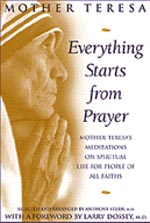
Her meditations present unorthodox notions of God and love |
She is lauded as a great ecumenical teacher of prayer. Those who praise her spiritual meditations read like a line-up from an Assisi Prayer Encounter: a Jewish Rabbi, a Zen teacher, a Tibetan Buddhist master, a Protestant minister, and the President of the U.S. Conference of Catholic Bishops, among others. The latter, Bishop Anthony Pilla, calls the meditations “kernels of truth … deep in wisdom and spiritual insight”. (2)
Here is one of those “kernels.” Mother Teresa stated:
“Some call Him Ishwar, some call Him Allah, some simply God, but we have to acknowledge that it is He who made us for greater things: to love and be loved. What matters is that we love. We cannot love without prayer, and so whatever religion we are, we must pray together.” (3)
This is not an isolated statement taken out of context. It is one of many such testimonials indicating Mother Teresa’s general attitude of indifference to what creed a man professed. (4) In this meditation, she shows an unorthodox notion of God, as well as a distorted notion of love.
An unorthodox notion of God
It is one thing to say that God has different names in different languages. For example, one says God in English, Dieu in French, Dios in Spanish, Gott in German, and so on. But it is obvious that the Spanish Catholics, French Catholics, German Catholics and American Catholics all understand the same reality by the word God.
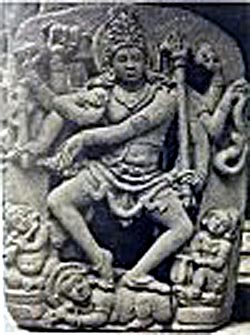
Shiva, one of representations of the Hindu divinity, does not coincide with the one true God Catholics adore |
Now, it’s another story to apply this to different creeds and beliefs, which claim quite varied notions about the First Cause that created the world and man. It is absolutely incorrect to say that Ishwar, Allah and the true God are all just different names for the same reality.
The Muslims deny the Trinity of the true God and divinity of Jesus Christ. Therefore, their Allah is far from being the same reality adored by Catholics. The god of Buddhists is not a person as is the true God. It is a kind of immanentist force essentially present in all creatures. Some Buddhist sects worship innumerable deities. The Hindus, following a different doctrine, also worship a whole world of deities, including spirits such as Ishwar, and men and animals like cows and snakes.
So, Mother Teresa presented a false supposition – that these “gods” are all the one true God Whom the Catholic Church adores. This assertion is completely wrong. It stands in opposition to simple natural reason and directly contradicts Catholic dogma.
It is hard to believe that Mother Teresa was beatified after making this kind of statement, which objectively reflects her typical thinking. It is likewise difficult to understand how Catholic authorities can praise such an assertion as a “kernel of truth.”
A false notion of love
Next, the idea she presents that every kind of love is good is, at best, very superficial. “What matters is that we love,” she said above. She repeats this notion often: e.g. “Love is a fruit in season at all times and within the reach of every hand. Anyone may gather it and no limit is set. Everyone can reach this love through meditation, the spirit of prayer and sacrifice. … If we learn to love, we learn to be holy.”
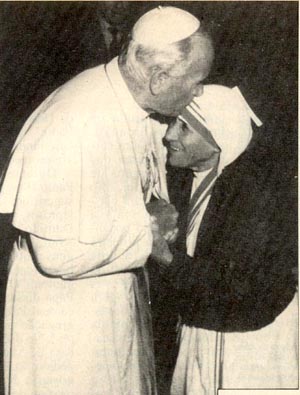
Mother Teresa and John Paul II, both partisans of the same false ecumenism - 30 Giorni, July 1990 |
What is love? Love is the adhesion of the will to a person, object or ideal. This relation per se is not good or bad, it depends on the purpose of the love. If someone loves with a bad purpose, this love is unworthy. If he loves something for the right cause, it is good. This is the reason why St. Augustine stated quite simply: Only the good can be loved. (5)
Therefore, when someone loves the true God, Who is all-good, this is a good thing. But if someone has affection toward something evil, toward something that he calls god but is really a devil, this is not a good thing. It is an evil passion, not a good love, and the person needs correction, not empathy. There are, in fact, limits set in love. St. Thomas Aquinas taught this clearly: Passions “are evil if the love is evil, and good if it is good”. (6)
This teaching is missing, however, in the meditation of Mother Teresa on God.
• First, she assumed the false supposition that God is the same for Muslims, pagans and Catholics.
• Second, she simplified the notion of love, and implied that one can love both the good and the evil, that the object of one’s love is an indifferent subject. All that matters is love. This contradicts the teaching of basic Catholic Catechism that instructs us to love the true God above all things.
A nun, even a very popular one, who would state these two errors would normally not be a blessed or a saint, since to achieve this honor her teachings on matters of Faith could not contain error, even a slight error. This is crucial not only because it involves the honor and integrity of the Church, but also because a blessed must be model of salvation for the Catholic faithful.
It is obvious that the love Mother Teresa was preaching in such meditations was not a model of Catholic love, nor is the “god” she points to the Most Holy Trinity of the Catholic Church.
Clearly the doctrinal concerns of some Catholics at this rapid beatification of Mother Teresa are fully justified. But disturbing doubts also lurk around the legitimacy of the miracle presented as proof of her sanctity.
An uncertain miracle
Normally the process of beatification can only begin after the candidate is deceased for five years, and after proof of one miracle is given. Miracles are something the Church does not take lightly. In cases of physical cures, it must be clear, without a shadow of a doubt, that the cure cannot have a natural cause.
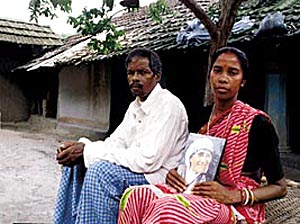
Monica Besra, who claims a miracle, and her husband Seiku, who thinks his wife was cured by the doctors - Time, , October 21, 2002 |
Now, in the case of Mother Teresa, John Paul II waived the five-year waiting period. Then, in 2002 the Vatican recognized one miracle, the cure of Monica Besra, a 35-year-old villager from northern India cured of an ovarian tumor. Besra and the Missionaries of Charity claim that the tumor vanished in September 1998 when a medallion with an image of the late Albanian nun was applied to the site of her pain.
However, Dr. Ranjan Mustafi, chief gynecologist who treated the woman at Balurghat District Hospital in West Bengal, says that it was quite possible that his patient was cured by four anti-TB drugs she was taking at the time, which could have dissolved the tumor. He said he admires Mother Teresa greatly and thinks she should be beatified for her work among the poor. But not for this case. “She [Besra] had a medical disease which was cured by medical science, not by any miracle,” he says.(7)
His hospital superiors back him up, saying that records show she responded to the treatment steadily. Five doctors in Rome consulted by the Vatican on the case disregarded this scientific probability and hastily agreed there was no medical explanation for the cure. Mustafi said he was never contacted by the Vatican. (8)
Monica Besra, of course, believes in the miracle, but admits that she was receiving medical treatments from the doctors at the state-run Balurghat Hospital at that time. “Those who love Mother will believe,” she says simply. That she loves Mother Teresa there is no doubt. But it is not sentiment that determines the value of a miracle in the normal processes of the Catholic Church…
Conclusion
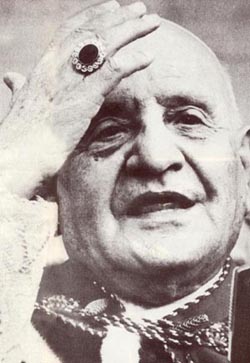
Analogous questions rise over the beatification of John XXIII
30 Giorni, May 1998 |
So what do we have? Faulty notions of God and love. A miracle shrouded in doubt. A process put on fast-track by a Pope who has himself championed the wrong notion of theological pluralism. This concept implies admittance that there is not just one Revelation and one uniform interpretation of it, as the Catholic Church has always taught, but that the “revelations” and false interpretations of other religions would also be correct.
It certainly leads one to seriously suspect that the intention of John Paul II was not just to beatify a person, in this case, Mother Teresa, but to “canonize” the post-Conciliar progressivist thinking on ecumenism and universal salvation that she adhered to.
This beatification also raises suspicions about others, such as that of John XXIII, whose “incorrupt” body was demonstrated to be preserved by scientific means, and who always supported the Modernist errors. One can’t help but wonder what has happened: Has the Catholic Faith changed, or does a person no longer need to profess it to be beatified?

1. Everything starts from prayer : Mother Teresa's meditations on spiritual life for people of all faiths. Ashland, Or. : White Cloud Press, 2000, p. xii.
2. Ibid., in "Praise for Everything Starts from Prayer", page immediately following cover.
3. Ibid., p. 11.
4. Stern recounts the following incident as another example of her ecumenical spirit in action: Once, when Mother Teresa was ministering to a dying Buddhist man, a visitor overheard her whisper, “You say a prayer in your religion, and I will say a prayer as I know it. Together we will say this prayer and it will be something beautiful for God.” Source: Everything Starts From Prayer, ibid., Foreword, p. xvi.
5. De Trinitate, 8,3,4: PL 42: 949-50.
6. Summa Theologica, I-II, 24, 3.
7. “Too Swift to Sainthood,” Newsday, October 15, 2003.
8. Beth Duff-Brown, “To believers, proof of miracle not needed,” National AP Courier and Press internet site, October 18, 2003.
Posted October 29, 2003

Related Topics of Interest
 Religious Indifferentism Religious Indifferentism
 The Incorrupt Pope and the Pharaohs The Incorrupt Pope and the Pharaohs
 Contribution to a Canonization Contribution to a Canonization

|
Vatican II | Hot Topics |
Home | Books | CDs
| Search | Contact Us
| Donate

© 2002- Tradition in Action, Inc. All Rights Reserved
|
 |
|